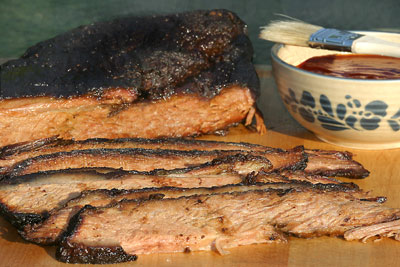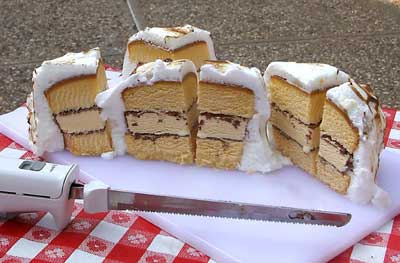By Mike Stines, Ph. B.
One of my traditional favorites for the smoker, grill, summer get-togethers and tailgating parties is sausage. Whether it’s smoky Louisiana andouille, spicy Mexican chorizo, Texas hot links or German bratwurst, sausage is a perennial favorite on the grill. Food historians can’t document the start of sausage making but we know that the process began as a way to preserve meat that couldn’t be immediately eaten. Today most sausage comes from familiar cuts such as the shoulder and leg, early sausage makers used parts of the animal that couldn’t be used in other ways, such as the liver and heart. There are more than 250 commercial varieties of sausage sold today—fresh, uncooked smoked, cooked smoked, semi-dry and dry. Interestingly, food historians can trace almost every variety to a country and often a town of origin. For the home sausage maker, fresh, cooked and uncooked smoked sausages are the easiest to prepare. Semi-dry and dry sausages (such as salami and pepperoni) must be dried under carefully controlled conditions to avoid bacterial contamination.
SAUSAGE-MAKING SUPPLIES
Meat Grinder
If you don’t want to purchase a meat grinder, you can always purchase the meat ground by your butcher, but by grinding you own meat, you’ll know exactly what goes into the finished sausage.
Sausage Stuffer
Most meat grinders come with sausage stuffing tubes, but if you’re doing a large amount of sausage at one time, you’ll want to look at a dedicated vertical stuffer that can hold a large quantity of sausage mixture.
Thermometer
An accurate thermometer is critical for food safety, especially when preparing sausage. The thermometer I use is the $89 ThermoPen instant-response thermometer by ThermoWorks (ThermoWorks.com). It’s incredibly fast and accurate within tenths of a degree.
Sausage Casings
Sausage doesn’t need to be stuffed into casings, it may be made into free-form logs or patties. But to stuff sausages you’ll need a sausage stuffer or stuffing tubes (see above) and sausage casings. Sheep, hog and beef intestines are traditionally used for casings although synthetic casings made of collagen are now available. SausageSource.com is a good on-line source of casings and sausage-making supplies with a retail store in Hillsborough, N.H.
Kitchen Scale
Although a digital scale is not a requirement for making sausage, digital scales are much more accurate than spring scales. I use the KD-7000 Professional from MyWeigh.com (the suggested retail price is $99.90 but it is available on-line for about $45). The scale is accurate to 1 gram (0.1 ounce) and has a capacity of 15.4 pounds, more than enough for most sausage-making tasks.
Smoker
While I have a variety of smokers and grills, my preference for cooking sausage is the Cookshack Smokette (cookshack.com) fitted with some jerky rods to allow the sausage to hang during smoking and cooking. The $499 Smokette is an electric smoker that uses wood chips for smoking (about one cup of chips for every 10 pounds of meat) and has a capacity of 25 to 30 pounds. Because it’s electric, the temperature is thermostatically controlled from 100 to 250 degrees F. that is perfect for regulating the heat needed to prepare great sausage.
Smoking Wood
Almost any hardwood, or a combination of hardwoods, can be used to smoke sausage and other meats. The most popular for sausage-smoking are apple and cherry (slightly sweet smoke), alder (mild smoke) and hickory (sharp smoke). Smoking pellets, such as those manufactured by BBQr’s Delight (bbqrsdelight.com) may also be used. Candy Weaver of BBQr’s Delight notes slightly less than 1/4 cup of pellets equals one cup of wood chips.
As with any cooking, finished sausage is only as good as the ingredients. The meat should be fresh, high quality, and have the proper fat ratio. Avoid meat that has been “enhanced” with added water and salt. Spices and seasonings should also be fresh, not something that’s been hanging around in the pantry for the past two years.
For most sausages, the meat is coarsely ground and then mixed with herbs and spices. The mixture is then ground again to a finer grind and stuffed into casings or formed into patties.
Important: About Food Safety
Cleanliness and sanitized working surfaces are always important during food preparation but even more so when working with ground meats. Always wash the grinder plates, auger, feed tube and other equipment in hot, soapy water before and after use. Soak the parts in a solution of one tablespoon bleach and one gallon of warm water for a few minutes, rinse and air dry. Lightly coat the cutting plates and blade with mineral oil between uses and wrap in butcher’s paper to prevent rust or discoloration.
Ground meat must be kept cold during mixing to prevent the fat from beginning to render and to reduce the potential of food borne illness. Refrigerate or lightly freeze ground meats before stuffing the mixture into casings; keep the grinder auger and stuffing tubes cold by placing them in the refrigerator for about 30 minutes before use.
When finished grinding meat, run a piece or two of bread through the grinder to help clear out any remaining particles and thoroughly wash all the parts in hot, soapy water.
Hawgeyes’ Summer Sausage

20 pounds lean ground beef or venison
10 pounds coarsely ground pork (not lean)
1 Hi Mountain Summer Sausage kit (all packets)
3 ounces encapsulated citric acid
1 1/2 cups Frank’s® Original Red Hot sauc
1 1/2 cups ice cold buttermilk
1 1/2 cups ice water
20 feet 1 1/2-inch collagen casings
Soak the collagen casings in warm water for 1 hour.
In a large mixing bowl, combine all of the ingredients and mix thoroughly. Stuff the mixture into the casings and refrigerate for 18 to 24 hours.
Hang the sausages in a cooker or oven and cook for 1 hour at 120 degrees F. with no smoke; increase the temperature to 140 degrees F., add your favorite wood and smoke-cook for another 1 hour. Increase the heat to 160 degrees F. and continue smoking for another 30 minutes. Increase the heat to 180 degrees F. and continue smoking until the sausages have an internal temperature of 152 degrees F. The entire cooking process will take about 7 hours.
When the sausages hit 152 degrees F., give them a quick hot shower to clean, and then put them into a tub of ice water to chill. Remove the sausages, dry them and refrigerate. Vacuum sealed sausages will keep fresh for 2 to 3 weeks.
Yield: 30 pounds of sausage
Heat scale: Medium
Hot Links
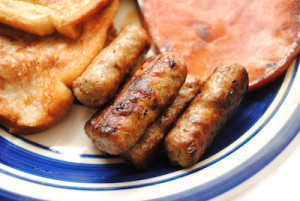 Hot Links are found throughout Texas and make a great sandwich when smothered with tangy barbecue sauce, or as an ingredient with beans or boiled greens. They make excellent breakfast sausages, as shown above. This recipe is adapted from Bruce Aidells’ “Complete Sausage Book” (Ten Speed Press, 2000) and requires advance preparation.
Hot Links are found throughout Texas and make a great sandwich when smothered with tangy barbecue sauce, or as an ingredient with beans or boiled greens. They make excellent breakfast sausages, as shown above. This recipe is adapted from Bruce Aidells’ “Complete Sausage Book” (Ten Speed Press, 2000) and requires advance preparation.
1 1/2 pounds beef chuck
1/2 pound pork shoulder
1 pound pork fat back
1/2 cup water
2 tablespoons finely chopped garlic
1 1/2 tablespoons kosher salt
1 tablespoon sweet Hungarian paprika
1 tablespoon coarsely ground black pepper
2 teaspoons granulated sugar
1 teaspoon dried marjoram
2 teaspoons ground cayenne pepper
1/2 teaspoon dried sage
1 pinch each: ground allspice, cardamom, cloves, coriander and cinnamon
Medium hog casings
Grind the meats and fat through a 3/16-inch plate. In a large bowl, mix the ground fat and meats with the water, garlic, salt, paprika, black pepper, sugar, marjoram, cayenne, sage, allspice, cardamom, cloves, coriander and cinnamon. Knead with your hands until everything is well blended.
Stuff into medium hog casings, and tie into 6-inch links. Dry overnight on a rack in the refrigerator.
Hot smoke until the internal temperature of the sausages reaches 155 to 160 degrees F.
Hot Links will keep in the refrigerator for 5 days or in the freezer for 2 months.
Yield: 3 1/4 pounds
Heat scale: Medium
Smoked Bratwurst
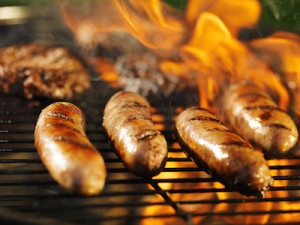
Bratwurst is German sausage made of pork and veal seasoned with a variety of spices including ginger, nutmeg and coriander or caraway. Beef may also be substituted for the veal. Bratwurst can be roasted, grilled or pan-fried. Bratwurst is often served in a Brat roll (not a hot dog roll) and eaten with spicy German mustard, grilled or sautéed onions, grilled or sautéed peppers and sometimes sauerkraut. Serve with lots of Bratwash (beer). (You can find Prague Powder #1 at sausagesource.com.)
3 pounds pork butt
2 pounds veal shoulder
1 1/2 tablespoons coarse kosher salt
2 1/2 teaspoons onion salt
2 1/2 teaspoons ground white pepper
2 1/2 teaspoons marjoram
2 1/2 teaspoons dried parsley
1 teaspoon ground nutmeg
1 teaspoon celery seed
1 teaspoon Prague Powder # 1
1/2 teaspoon ground ginger
1/2 teaspoon mace
1/2 teaspoon cardamom
1/2 cup red wine
6 feet hog casings
1 cup hickory wood shavings (about 1 ounce)
Grind the pork and veal mixture through a 3/16-inch plate.
Mix the remaining ingredients in a stainless steel bowl and add the ground meats; mix thoroughly. Cover and chill in the freezer for 30 minutes. Remove from the freezer and grind again with a 1/4-inch plate.
Stuff the mixture into hog casings and allow the sausage to air dry for 30 minutes or until dry to the touch. Refrigerate for up to 3 days or freeze for up to 3 months.
To cook the sausage: Dry the sausages in the smoker for 1 hour at 110 degrees F. with the door slightly opened. Increase the smoker temperature to 170 degrees F., add the hickory wood, and smoke-cook until the internal temperature of the sausage is 155 degrees F., about 3 to 4 hours.
Transfer the sausages to ice water bath until cooled, about 30 minutes.
Yield: 10 to 14 links
Heat Scale: Mild
British Bangers With Attitude
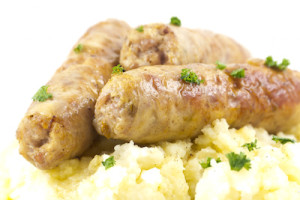
“Banger” is a British and Irish colloquialism for sausage. Most bangers are pretty mild in flavor but this recipe adds some heat to the sausages with the addition of cayenne and crushed red pepper flakes.Shown above is a famous British breakfast, bangers and mash (that would be mashed potatoes).
1/2 pound ground pork
1/2 pound ground veal
6 ounces ground suet
3 slices white bread made into bread crumbs
2 teaspoons dried sage
2 teaspoons onion powder
1 teaspoon grated lemon peel
1 teaspoon seasoned salt
1 teaspoon crushed red pepper flakes
1/2 teaspoon lemon pepper
1/2 teaspoon black pepper
1/2 teaspoon ground cayenne chile
1/4 teaspoon grated nutmeg
1/4 teaspoon mace
1/4 teaspoon dried thyme
1/4 teaspoon dried marjoram
1 large egg
5 feet hog casings
Knead the pork, veal, suet and bread in a medium mixing bowl. Add the remaining ingredients (except the hog casings) and mix well to incorporate.
Stuff the mixture into hog casings.
Finished bangers may be poached, broiled or grilled.
Yield: 8 links
Heat Scale: Medium
Chorizo
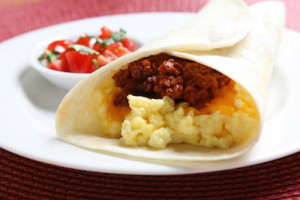
This is Dave DeWitt’s recipe for a traditional Mexican sausage that’s often served with huevos rancheros for breakfast. Unlike other sausages, it is not usually stuffed into casings but served crumbled or formed into patties. (There are two varieties of chorizo: this Mexican version that is made with fresh pork, and Spanish chorizo, made with smoked pork.) This recipe requires advance preparation.
2 pounds ground pork
1/2 cup hot red chile powder
1/2 cup cider vinegar
1 teaspoon dried Mexican oregano
1 clove garlic (about 1 teaspoon)
1/2 teaspoon freshly ground black pepper
1/2 teaspoon kosher salt
1/4 teaspoon each: ground cloves, cinnamon, oregano and cumin
In a food processor or blender, combine the non-pork ingredients and mix thoroughly.
Knead this mixture into the pork until it is thoroughly mixed. Cover and refrigerate for at least a day. At this point the chorizo may be frozen for up to 3 months or cooked.
To cook, crumble the chorizo in a skillet and fry. Drain before serving.
Yield: 8 servings
Heat Scale: Medium
Louisiana Hickory-Smoked Andouille
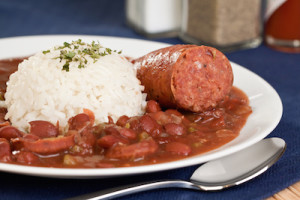
Andouille is made with pork butt and pork fat and seasoned with salt, cracked black pepper and garlic. Traditionally, the sausage is then smoked over pecan wood and sugar cane at 175 degrees F. for seven to eight hours. This recipe uses hickory and pecan wood and requires advance preparation. (You can find Prague Powder #1 at sausagesource.com.)
2 3/4 pounds pork butt cut into 1-inch pieces
2 tablespoons coarsely ground black pepper
2 tablespoons finely minced garlic
4 teaspoons granulated sugar
1 tablespoon ancho chile powder
1 tablespoon coarse kosher salt
1 tablespoon hot Hungarian paprika
3/4 teaspoon ground cayenne chile
3/4 teaspoon crushed red pepper flakes
3/4 teaspoon dried thyme
1/2 teaspoon Prague Powder #1
1/2 teaspoon Filé (ground sassafras) powder
3/4 cup hickory chips
5 feet hog casings
Grind the pork cubes through a 3/16-inch plate into a large mixing bowl. Add the remaining ingredients (except the hickory chips and casings) and mix thoroughly. Cover and refrigerate for at least 1 hour.
Replace the 3/16-inch plate and the cutting blade with a sausage-making plate and stuff the mixture into hog casings. Tie or twist the casings into 6-inch links. Allow the sausages to air-dry in a cool place for 2 hours.
Separately soak the pecan and hickory chips in water for 30 minutes. Put a small disposable aluminum pan in the center of a kettle grill and mound 15 charcoal briquettes on each side. Open the bottom vents on the grill. Light the charcoal and allow the fire to burn until the briquettes are ash-covered. Drain the hickory chips and distribute them over the charcoal.
Place the sausage links on the grilling rack over the pan. Cover the grill, open the top vents and smoke the sausages at 150 degrees F. for about 2 hours; raise the temperature to 170 degrees F. and add the hickory chips; continue cooking until the links reach an internal temperature of 160 degrees F., another 3 to four 4. Remove the sausages from the grill, rinse with cold water and cool. Allow the andouille to hang at room temperature for 1 hour.
Smoked andouille can be kept in the refrigerator for 5 days or frozen for up to 3 months.
Yield: 8 to 10 (5-inch/3.75-ounce) links
Heat scale: Medium
Boudin Blanc
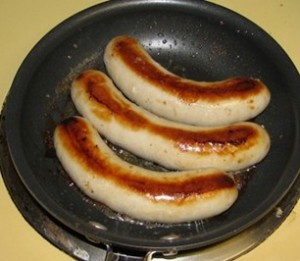 Boudin Blanc is a Cajun sausage made with pork and rice. It may be stuffed into hog casings, formed into patties or shaped into balls (similar to meatballs) and deep-fried. When eating Boudin, the casings are rarely eaten and the mixture is simply squeezed out of the casings.
Boudin Blanc is a Cajun sausage made with pork and rice. It may be stuffed into hog casings, formed into patties or shaped into balls (similar to meatballs) and deep-fried. When eating Boudin, the casings are rarely eaten and the mixture is simply squeezed out of the casings.
2 3/4 pounds pork butt, cut into 1-inch chunks
1 pound pork liver, cut into 1-inch pieces
2 quarts water
1 medium yellow onion, chopped (about 1 cup)
1/2 cup chopped bell pepper
1/2 cup chopped celery
1 teaspoon coarse kosher salt
2 teaspoons ground cayenne chile, divided
1 1/2 teaspoons black pepper, divided
1 cup minced flat-leaf parsley, divided
6 cups cooked white rice
1 tablespoon Cajun seasoning
1 1/4 cups chopped green onions, divided
6 feet hog casings
Put the pork, liver, water, onion, bell pepper, celery, salt, 1/4 teaspoon cayenne and 1/4 teaspoon black pepper in a large heavy pot. Bring to a boil, reduce heat and simmer for about 2 hours. Drain and reserve 2 cups of the broth.
Grind the pork and liver together with 1/2 cup parsley and 2/3 cup green onions in a meat grinder fitted with a 1/4-inch plate. Place the mixture in a large bowl and add the rice, the Cajun seasoning and the remaining cayenne, black pepper, parsley and green onions; mix well. Slowly add the reserved broth and mix. Cool the mixture in the refrigerator for at least 30 minutes. Grind the mixture again using a 3/16-inch plate and stuff into hog casings or form into patties.
Cook the links by steaming them over medium heat for 15 to 20 minutes. Boudin patties may be pan-fried and make a great breakfast side dish.
Yield: 16 links
Heat scale: Mild to medium
Barbecue editor Mike Stines is the author of the critically acclaimed “Mastering Barbecue” (Ten Speed Press, 2005). He has been conferred a doctorate in barbeque philosophy (Ph.B.) by the Kansas City Barbeque Society and is one of 26 persons in the world to hold the Greasehouse University degree. His website is CapeCodBBQ.com.






